-
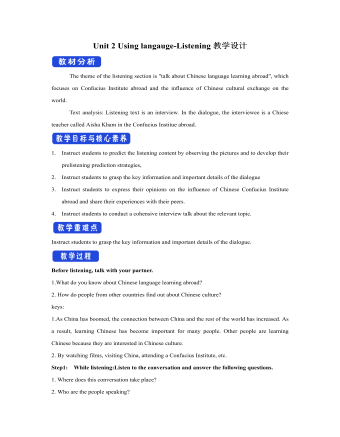
新人教版高中英语选修2Unit 2 Using langauge-Listening教学设计
? B: Absolutely! Getting involved with Chinese cultural activities there definitely helped a lot. I got to practice my Chinese on a daily basis, and I could learn how native Chinese speakers spoke.? A: What do you feel is your biggest achievement?? B: Learning Chinese characters! I have learnt about 1,500 so far. When I first started, I didn't think it was even going to be possible to learn so many, but now I find that I can read signs, menus, and even some easy newspaper articles.? A: What are you most keen on?? B: I've really become keen on learning more about the Chinese culture, in particular Chinese calligraphy. As I have learnt Chinese characters, I have developed a great appreciation for their meaning. I want to explore Chinese characters by learning how to write them in a more beautiful way. ? A: Finally, what do you want to say to anyone interested in learning Chinese?? I have really become keen on learning more about the Chinese culture, in particular Chinese Calligraphy. As I have learnt Chinese character, I have developed a great appreciation for their meaning. I want to explore Chinese characters by learning how to write them in a more beautiful way.? A: Finally, what do you want to say to anyone interested in learning Chinese?? B: I'd say, give it a shot! While some aspects may be difficult, it is quite rewarding and you will be happy that you tried.? A: Thanks for your time. ? B:You're welcome.

新人教版高中英语选修2Unit 3 Using langauge-Listening教学设计
1. How is Hunan cuisine somewhat different from Sichuan cuisine?The heat in Sichuan cuisine comes from chilies and Sichuan peppercorns. Human cuisine is often hotter and the heat comes from just chilies.2.What are the reasons why Hunan people like spicy food?Because they are a bold people. But many Chinese people think that hot food helps them overcome the effects of rainy or wet weather.3.Why do so many people love steamed fish head covered with chilies?People love it because the meat is quite tender and there are very few small bones.4.Why does Tingting recommend bridge tofu instead of dry pot duck with golden buns?Because bridge tofu has a lighter taste.5 .Why is red braised pork the most famous dish?Because Chairman Mao was from Hunan, and this was his favorite food.Step 5: Instruct students to make a short presentation to the class about your choice. Use the example and useful phrases below to help them.? In groups of three, discuss what types of restaurant you would like to take a foreign visitor to, and why. Then take turns role-playing taking your foreign guest to the restaurant you have chosen. One of you should act as the foreign guest, one as the Chinese host, and one as the waiter or waitress. You may start like this:? EXAMPLE? A: I really love spicy food, so what dish would you recommend?? B: I suggest Mapo tofu.? A: Really ? what's that?

新人教版高中英语选修2Unit 4 Learning about Language教学设计
This section guides students to pay attention to the typical context of vocabulary use, helps students accumulate vocabulary around the key vocabulary of this unit, and uses the learned words and word chunks in different contexts to deeply understand their meaning and usage, so as to achieve the purpose of review and consolidation.The teaching design activities aim to guide students to pay attention to the typical context in which the target vocabulary is used, as well as the common vocabulary used in collocation, so that students can complete the sentence with correct words. In terms of vocabulary learning strategies, this unit focuses on cultivating students' ability to pay attention to collocation of words and to use word blocks to express meaning.For vocabulary learning, it is not enough just to know the meaning of a single word, but the most important thing is to master the common collocations of words, namely word blocks.Teachers should timely guide students to summarize common vocabulary collocation, such as verb and noun collocation, verb and preposition collocation, preposition and noun collocation, and so on.1. Guide students to understand and consolidate the meaning and usage of the vocabulary in the context, 2. Guide the students to use the unit topic vocabulary in a richer context3. Let the students sort out and accumulate the accumulated vocabulary, establishes the semantic connection between the vocabulary,4. Enable students to understand and master the vocabulary more effectivelyGuiding the Ss to use unit topic words and the sentence patterns in a richer context.

新人教版高中英语选修2Unit 4 Reading for writing教学设计
假定你是英国的Jack,打算来中国旅行,请你给你的中国笔友李华写一封信,要点如下:1.你的旅行计划:北京→泰山→杭州;2.征求建议并询问他是否愿意充当你的导游。注意:1.词数80左右(开头和结尾已给出,不计入总词数);2.可以适当增加细节,以使行文连贯。参考词汇:故宫 the Forbidden City;泰山 Mount TaiDear Li Hua,I'm glad to tell you that 'm going to visit China.First,I am planning to visit Beijing,the capitalof China,where I am looking forward to enjoying the Great Wall,the Forbidden City and somebeautiful parks.Then I intend to go to visit Mount Tai in Shandong Province.I've heard that it is one ofthe most famous mountains in China and I can't wait to enjoy the amazing sunrise there.After that,I amalso going to Hangzhou.It is said that it is a beautiful modern city with breathtaking natural sights,among which the West Lake is a well- known tourist attraction.What do you think of my travel plan? Will you act as my guide? Hope to hear from you soon.

新人教版高中英语选修2Unit 4 Using langauge-Listening教学设计
The theme of the listening section is " talking about scenery and culture along a journey."The part is designed to further lead the students to understand Canadian natural geography and social environment, and integrated into the cultural contrast by mentioning the long train journey from Beijing to Moscow routes. On this basis, the part activates students related travel experience, lets the student serial dialogue, guides the student to explore further the pleasure and meaning of the long journey, and Chinese and foreign cultural comparison.The part also provides a framework for the continuation of the dialogue, which is designed to provide a framework for students to successfully complete their oral expressions, and to incorporate an important trading strategy to end the dialogue naturally.1. Help students to understand and master some common English idioms in the context, and experience the expression effect of English idioms.2. Guide the students to understand the identity of different people in the listening context, and finish the dialogue according to their own experience.3. Instruct the students to use appropriate language to express surprise and curiosity about space and place in the dialogue, and master the oral strategy of ending the dialogue naturally.1. Instruct students to grasp the key information and important details of the dialogue.2. Instruct students to conduct a similar talk on the relevant topic.

新人教版高中英语选修2Unit 5 Learning about Language教学设计
The purpose of this section of vocabulary exercises is to consolidate the key words in the first part of the reading text, let the students write the words according to the English definition, and focus on the detection of the meaning and spelling of the new words. The teaching design includes use English definition to explain words, which is conducive to improving students' interest in vocabulary learning, cultivating their sense of English language and thinking in English, and making students willing to use this method to better grasp the meaning of words, expand their vocabulary, and improve their ability of vocabulary application. Besides, the design offers more context including sentences and short passage for students to practice words flexibly.1. Guide students to understand and consolidate the meaning and usage of the vocabulary in the context, 2. Guide the students to use the unit topic vocabulary in a richer context3. Let the students sort out and accumulate the accumulated vocabulary, establishes the semantic connection between the vocabulary,4. Enable students to understand and master the vocabulary more effectivelyGuiding the Ss to use unit topic words and the sentence patterns in a richer context.Step1: Read the passage about chemical burns and fill in the blanks with the correct forms of the words in the box.

新人教版高中英语选修2Unit 5 Reading and thinking教学设计
The theme of this activity is to learn the first aid knowledge of burns. Burns is common in life, but there are some misunderstandings in manual treatment. This activity provides students with correct first aid methods, so as not to take them for granted in an emergency. This section guides students to analyze the causes of scald and help students avoid such things. From the perspective of text structure and collaborative features, the text is expository. Expository, with explanation as the main way of expression, transmits knowledge and information to readers by analyzing concepts and elaborating examples. This text arranges the information in logical order, clearly presents three parts of the content through the subtitle, accurately describes the causes, types, characteristics and first aid measures of burns, and some paragraphs use topic sentences to summarize the main idea, and the level is very clear.1. Guide students to understand the causes, types, characteristics and first aid methods of burns, through reading2. Enhance students’ ability to deal withburnss and their awareness of burns prevention3. Enable students to improve the ability to judge the types of texts accurately and to master the characteristics and writing techniques of expository texts.Guide students to understand the causes, types, characteristics and first aid methods of burns, through readingStep1: Lead in by discussing the related topic:1. What first-aid techniques do you know of ?CPR; mouth to mouth artificial respiration; the Heimlich Manoeuvre

新人教版高中英语选修2Unit 5 Using langauge-Listening教学设计
The theme of this section is to learn how to make emergency calls. Students should learn how to make emergency calls not only in China, but also in foreign countries in English, so that they can be prepared for future situations outside the home.The emergency telephone number is a vital hotline, which should be the most clear, rapid and effective communication with the acute operator.This section helps students to understand the emergency calls in some countries and the precautions for making emergency calls. Through the study of this section, students can accumulate common expressions and sentence patterns in this context. 1.Help students accumulate emergency telephone numbers in different countries and learn more about first aid2.Guide the students to understand the contents and instructions of the telephone, grasp the characteristics of the emergency telephone and the requirements of the emergency telephone.3.Guide students to understand the first aid instructions of the operators.4.Enable Ss to make simulated emergency calls with their partners in the language they have learned1. Instruct students to grasp the key information and important details of the dialogue.2. Instruct students to conduct a similar talk on the relevant topic.Step1:Look and discuss:Match the pictures below to the medical emergencies, and then discuss the questions in groups.
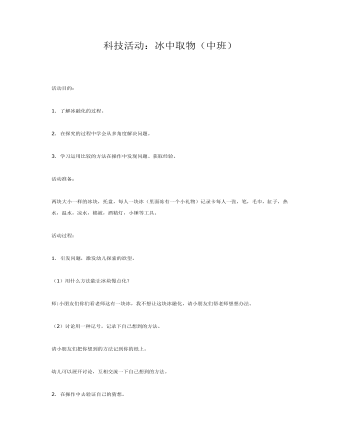
中班科学冰中取物课件教案
2. 在探究的过程中学会从多角度解决问题。3. 学习运用比较的方法在操作中发现问题、获取经验。活动准备:两块大小一样的冰块,托盘,每人一块冰(里面冻有一个小礼物)记录卡每人一张,笔,毛巾,缸子,热水,温水,凉水,棉被,酒精灯,小锤等工具。活动过程:1. 引发问题,激发幼儿探索的欲望。(1)用什么方法能让冰块慢点化?师:小朋友们你们看老师这有一块冰,我不想让这块冰融化,请小朋友们帮老师想想办法。
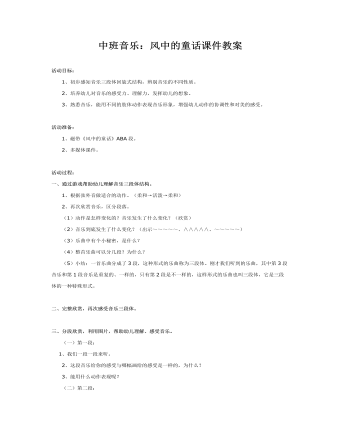
中班音乐:风中的童话课件教案
2、培养幼儿对音乐的感受力、理解力,发挥幼儿的想象。3、熟悉音乐,能用不同的肢体动作表现音乐形象,增强幼儿动作的协调性和对美的感受。 活动准备:1、磁带《风中的童话》ABA段。2、多媒体课件。 活动过程:一、通过游戏帮助幼儿理解音乐三段体结构。1、根据弦外音做适合的动作。(柔和→活泼→柔和)2、再次欣赏音乐,区分段落。 (1)动作是怎样变化的?音乐发生了什么变化?(欣赏) (2)音乐到底发生了什么变化?(出示~~~~~、∧∧∧∧∧、~~~~~) (3)乐曲中有个小秘密,是什么? (4)整首乐曲可以分几段?为什么? (5)小结:一首乐曲分成了3段,这种形式的乐曲称为三段体。刚才我们听到的乐曲,其中第3段音乐和第1段音乐是重复的、一样的,只有第2段是不一样的,这样形式的乐曲也叫三段体,它是三段体的一种特殊形式。
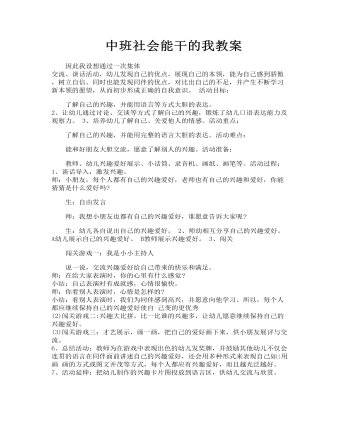
能干的小手中班教案中班社会能干的我教案
1、谈话导入,激发兴趣。 师:小朋友,每个人都有自己的兴趣爱好,老师也有自己的兴趣和爱好,你能猜猜是什么爱好吗? 生:自由发言 师:我想小朋友也都有自己的兴趣爱好,谁愿意告诉大家呢? 生:幼儿各自说出自己的兴趣爱好。 2、师幼相互分享自己的兴趣爱好。A幼儿展示自己的兴趣爱好。 B教师展示兴趣爱好。 3、闯关 闯关游戏一:我是小小主持人
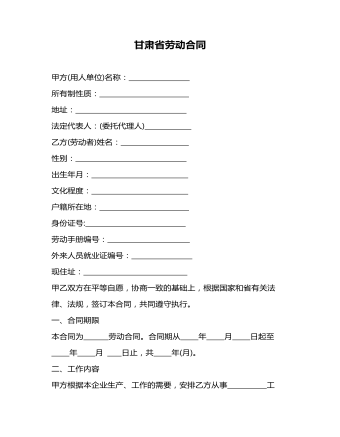
甘肃省劳动合同
四、工作时间和劳动报酬1、甲方实行每日不超过8小时,平均每周小时工时制,按国务院关于职工工作时间有关规定执行。甲方因生产(工作)需要,经与工会和乙方协商可延长工作时间,一般每日不超过l小时,特殊情况,每日不超过3小时,每月不得超过36小时。2、合同期间,甲方应按国家和企业的规定发给乙方工资、奖金、津贴、补贴,甲方支付乙方工资不得低于山西省人民政府规定的最低工资标准。3、甲方安排乙方加班加点,休息日法定休假日安排工作的,应按国家规定安排乙方安排同等时间的调休或支付相应工资报酬。
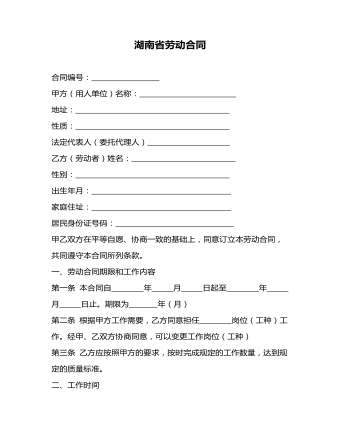
湖南省劳动合同
第二十九条下列情形之一,甲方可以解除本合同,但应提前三十日以书面形式通知乙方:1、乙方患病或非因工负伤,医疗期满后,不能从事原工作也不能从事甲方另行安排的工作的;2、乙方不能胜任工作,经过培训或者调整工作岗位,仍不能胜任工作的;3、双方不能依据本合同第二十六条规定就变更合同达成协议的。第三十条 甲方濒临破产进行法定整顿期间或者生产经营发生严重困难(地方政府规定的困难企业标准),经向工会或者全体职工说明情况,听取工会或者职工的意见,并向劳动保障行政部门报告后,可以解除本合同。
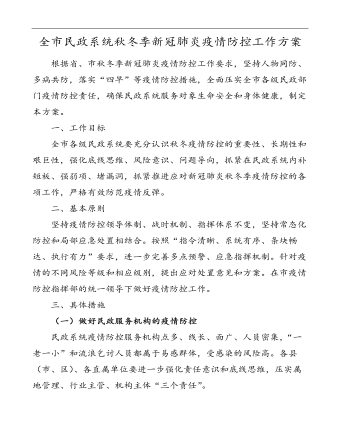
秋冬疫情防控全市民政系统秋冬季新冠肺炎疫情防控工作方案应急预案
一、工作目标全市各级民政系统要充分认识秋冬疫情防控的重要性、长期性和艰巨性,强化底线思维、风险意识、问题导向,抓紧在民政系统内补短板、强弱项、堵漏洞,抓紧推进应对新冠肺炎秋冬季疫情防控的各项工作,严格有效防范疫情反弹。二、基本原则坚持疫情防控领导体制、战时机制、指挥体系不变,坚持常态化防控和局部应急处置相结合。按照“指令清晰、系统有序、条块畅达、执行有力”要求,进一步完善多点预警、应急指挥机制。针对疫情的不同风险等级和相应级别,提出应对处置意见和方案。在市疫情防控指挥部的统一领导下做好疫情防控工作。

企业道路运输安全应急预案范文
(一)安全事故处置方案 1、发生安全生产事故,现场工作人员应立即采取处理措施,防止事故继续扩大并迅速报告; 2、总指挥根据事故报告立即到现场进行指挥,总指挥不在时由副总指挥负责指挥; 3、应急预案组织成员必须听从总指挥或副总指挥的统一调动和部署; 4、救护组进行现场救护,如有重伤人员应立即采取临时伤情处理并拨打急救电话送至医院抢救;现场工作人员施救时要注意自身安全和伤者再次受伤。
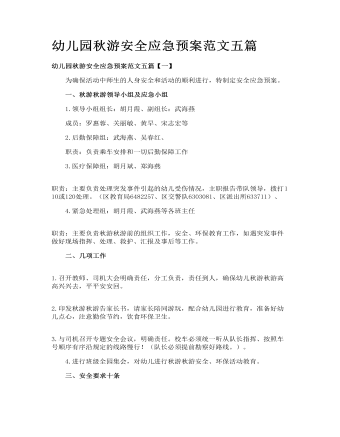
幼儿园秋游安全应急预案范文五篇
1.召开教师、司机大会明确责任,分工负责,责任到人,确保幼儿秋游秋游高高兴兴去,平平安安回。 2.印发秋游秋游告家长书,请家长陪同游玩,配合幼儿园进行教育,准备好幼儿点心,注意勤俭节约,饮食环保卫生。 3.与司机召开专题安全会议,明确责任。校车必须统一听从队长指挥、按照车号顺序有序沿规定的线路慢行!(队长必须提前勘察好路线。)。
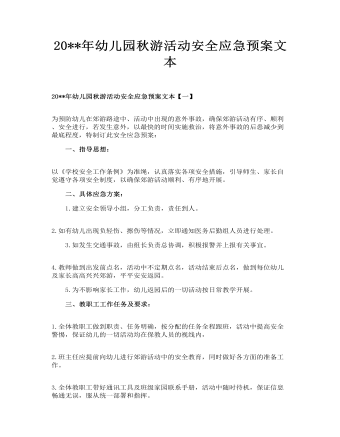
幼儿园秋游活动安全应急预案文本
二、具体应急方案: 1.建立安全领导小组,分工负责,责任到人。 2.如有幼儿出现负轻伤、擦伤等情况,立即通知医务后勤组人员进行处理。 3.如发生交通事故,由组长负责总协调,积极报警并上报有关事宜。 4.教师做到出发前点名,活动中不定期点名,活动结束后点名,做到每位幼儿及家长高高兴兴郊游,平平安安返园。 5.为不影响家长工作,幼儿返园后的一切活动按日常教学开展。
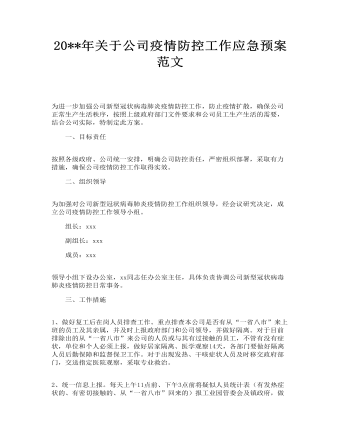
关于公司疫情防控工作应急预案范文
3、加强公司消毒防疫工作。办公室负责红外测温仪、消毒液、口罩等防护用品储备,在公司开展大面积消毒工作,对办公楼、餐厅、浴室、公司大门等公共场所,以及人员集中区域进行全面消毒,各单位积极做好配合工作。 4、加强疫情防护知识宣传。要加强疫情知识宣传普及,要通过网站、微信、橱窗、短信等途径广泛宣传。保安人员拦卡设岗,执勤人员要配备红袖章,建立来往人员台账登记;并做好温馨提示,将疫情防范措施张贴在员工出行醒目位置。各单位、各部门要教育员工正确认识疫情,科学防范疫情,做到不信谣、不传谣。
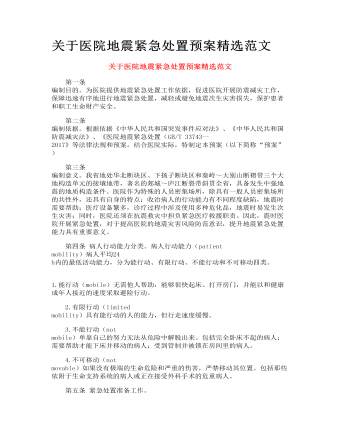
关于医院地震紧急处置预案精选范文
一)建(构)筑物达到当地抗震设防要求的,可引导就诊人员就近躲避在避险缓冲区、内承重墙的墙根、墙角以及桌椅、病床下面和坚固物体旁边。 (二)建(构)筑物未达到当地抗震设防要求的可按下列方法引导避险: 1.引导所处位置不超过二层且能行动的人员迅速撤离到室外安全地方;视具体情况帮助所处位置不超过二层且具有限行动能力的人员撤离到室外安全地方; 2.引导帮助所处位置超过二层和不能迅速撤离到室外安全地方的人员,就近躲避在避险缓冲区、内承重墙的墙根、墙角以及桌椅、病床和坚固物体旁边。
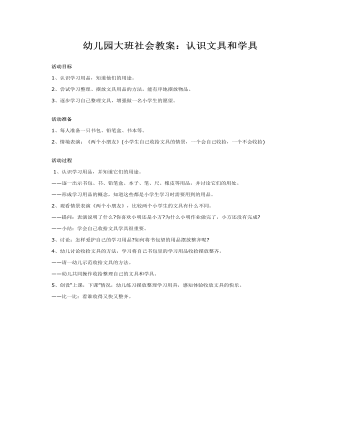
幼儿园大班社会教案:认识文具和学具
活动准备 1、每人准备一只书包、铅笔盒、书本等。 2、情境表演:《两个小朋友》(小学生自己收拾文具的情景,一个会自己收拾,一个不会收拾)活动过程 1、认识学习用品,并知道它们的用途。 ——逐一出示书包、书、铅笔盒、本子、笔、尺、橡皮等用品,并讨论它们的用处。 ——形成学习用品的概念,知道这些都是小学生学习时需要用到的用品。